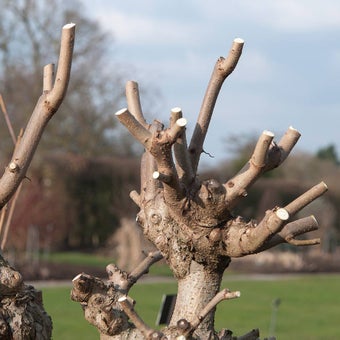
Quick facts
Suitable for - Acacia trees
Timing - Mid-spring (April), once the risk of frost has passed
Difficulty - Easy
Suitable for...
Young acacia specimens need some formative pruning to grow into well-shaped mature trees. Some species can also be trained into multi-stemmed bushes.
Established mature specimens are best pruned only minimally, removing dead, diseased or damaged growth and any misplaced branches that spoil the shape of the tree.
When to prune acacia
It is best to undertake any pruning in mid-spring (usually April), once the risk of frost has passed.
How to prune acacia
Formative pruning as a standard tree
Standard trees have a clear trunk and a head, or canopy, of branches. Young acacias can be grown as standards with a 1-2m (3¼-6½ ft) trunk.
Acacias grow with a clear central leading branch that grows upwards ahead of the other branches. It is important not to cut this central leader as this could spoil the final shape of the tree.
This method is suitable for Acacia dealbata and A. baileyana.
First year
- Remove all side branches from the lower third of the main stem
- Shorten by half all the sideshoots on the middle third of the main stem
- Leave the sideshoots on the top third of the main stem unpruned, apart from the removal of dead, diseased or damaged growth
- Cut to outward-facing so that the resulting growth extends outwards rather than into the centre of the tree
Second and third years
- Remove completely the sideshoots that were shortened by half in year one (which should be now be in the lower third of the tree)
- Shorten by half the sideshoots on the middle third of the tree
- Remove any crossing or misplaced branches in the upper third of the tree
Fourth and fifth years
- Clear the trunk of side branches to the height desired
- Continue to remove any crossing, dead, diseased or misplaced branches from the canopy
Then proceed as for a mature specimen.
Formative pruning as a multi-stemmed bush
This method is suitable for vigorous or suckering species, such as A. dealbata, A. longifolia and A. melanoxylon
First year
- Cut the main stem of a two year old tree straight across at the desired height, cutting as low as 8cm (3in) from ground level if required. Trim the wound so there are no rough edges
Second year
- Multiple branches should have regenerated from the wound and from below ground level. Select three or four of these (choosing strong, well-spaced branches) and remove all other branches completely, cutting them back to the base
Third and fourth year
- Allow sideshoots to develop from the chosen branches, removing only those sideshoots that are too low and dragging on the ground, or are crossing, rubbing or otherwise badly placed
- Remove any excess new stems arising from the base
- Occasional of congested side branches may be necessary as the bush matures
Mature specimens
Mature specimens need minimal pruning. In mid-spring check for, and remove, any of the following:
- Frost-damaged branches
- Branches that spoil the shape and symmetry of the plant
- Thin out plants that are extremely congested
- Cut back sideshoots that have flowered to two or three buds below the faded flowers
A. cultriformis, A. saligna and A. verticillata tolerate light clipping and can be grown as informal hedges.
Most mature acacias resent hard pruning, although suckering species may regenerate.

Problems
Late spring frosts can damage acacias which are not fully hardy, and some additional removal of damaged growth may be necessary if this occurs.
Apart from this, acacias are usually problem-free, but may occasionally be affected by the following brown leaves.




